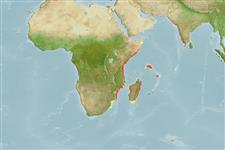Common names from other countries
>
Mulliformes (Goatfishes) >
Mullidae (Goatfishes)
Etymology: Parupeneus: Latin, parum, parvum = small + Peneus, the name of a river; minys: Name from the Greek word for small, referring to its very small adult size for this genus..
More on authors: Randall & Heemstra.
Environment: milieu / climate zone / depth range / distribution range
Ecologia
marino associati a barriera corallina; distribuzione batimetrica 43 - 55 m (Ref. 82838). Tropical
Distribuzione
Stati | Aree FAO | Ecosystems | Presenze | Point map | Introduzioni | Faunafri
Western Indian Ocean: Mozambique, Seychelles and India.
Size / Peso / Age
Maturity: Lm ? range ? - ? cm
Max length : 10.7 cm SL maschio/sesso non determinato; (Ref. 82838); 8.4 cm SL (female)
Short description
Chiavi di identificazione | Morfologia | Morfometria
Spine dorsali (totale) : 8; Raggi dorsali molli (totale) : 9; Spine anali: 0; Raggi anali molli: 7; Vertebre: 24. This species is distinguished by the following characters: pectoral-fin rays 15-16; gill rakers 6 + 21-22; elongated body, depth 3.95-4.3 in SL; head length 2.9-3.05 in SL; interorbital space flat medially; snout length 2.05-2.3 in HL; posterior edge of maxilla symmetrically convex with maximum depth of maxilla 5.45-5.8 in HL; barbel length 1.35-1.45 in HL; the longest dorsal spine 1.8-1.95 in HL; pectoral fins 1.3-1.4 in HL; pelvic fins 1.5-1.65 in HL; colour of alcohol preserved specimens uniform tan except those from the Seychelles with areas of white ventrally on head below eye and on lower two/fifths of body; dark markings absent; translucent fins pale yellowish. Colour when fresh, pink dorsally, pale pink to white ventrally, with an indistinct pale yellow stripe along lateral line; some lateral-line scales with a bluish white dash; a bluish white line encircling ventral part of eye and continuing obliquely to upper lip; 3 small bluish white blotches dorsally on head, one directly above eye; barbels white; median and pelvic fins translucent blotchy yellow with small pale blue to whitish spots along rays that outline faint transverse yellowish bands (Ref. 82838).
Life cycle and mating behavior
Maturities | Riproduzione | Spawnings | Egg(s) | Fecundities | Larve
Randall, J.E. and E. Heemstra, 2009. Three new goatfishes of the genus Parupeneus from the Western Indian Ocean, with resurrection of P. seychellensis. Smithiana Bulletin 10:37-50. (Ref. 82838)
IUCN Red List Status (Ref. 130435)
CITES (Ref. 128078)
Not Evaluated
Threat to humans
Harmless
Human uses
Strumenti
Special reports
Download XML
Fonti Internet
Estimates based on models
Preferred temperature (Ref.
115969): 25.5 - 26.1, mean 26.1 (based on 3 cells).
Phylogenetic diversity index (Ref.
82804): PD
50 = 0.5000 [Uniqueness, from 0.5 = low to 2.0 = high].
Bayesian length-weight: a=0.01202 (0.00556 - 0.02601), b=3.10 (2.93 - 3.27), in cm Total Length, based on LWR estimates for this Genus-body shape (Ref.
93245).
Trophic level (Ref.
69278): 3.3 ±0.4 se; based on size and trophs of closest relatives
Resilienza (Ref.
120179): Alto, tempo minimo di raddoppiamento della popolazione meno di 15 mesi (Preliminary K or Fecundity.).
Fishing Vulnerability (Ref.
59153): Low vulnerability (10 of 100).
